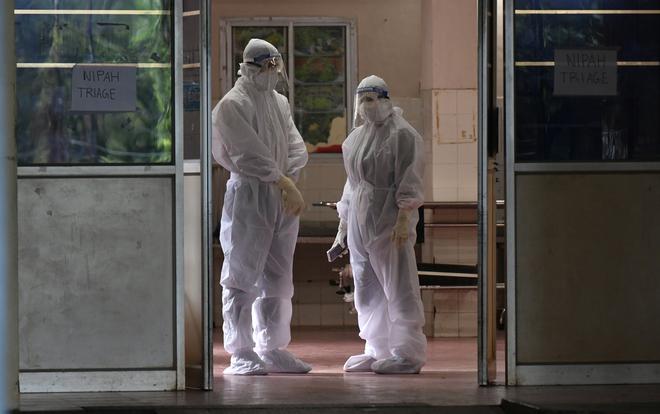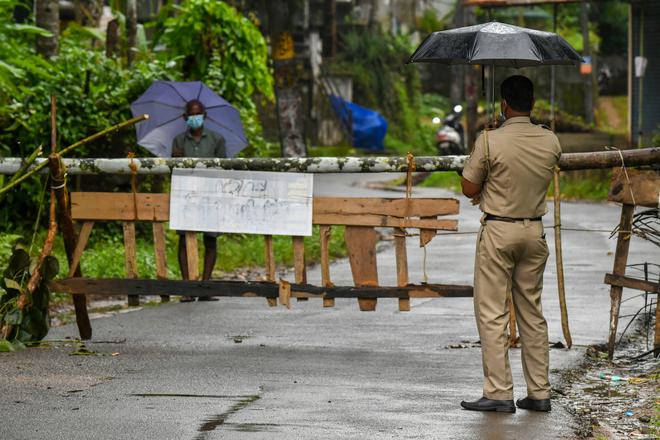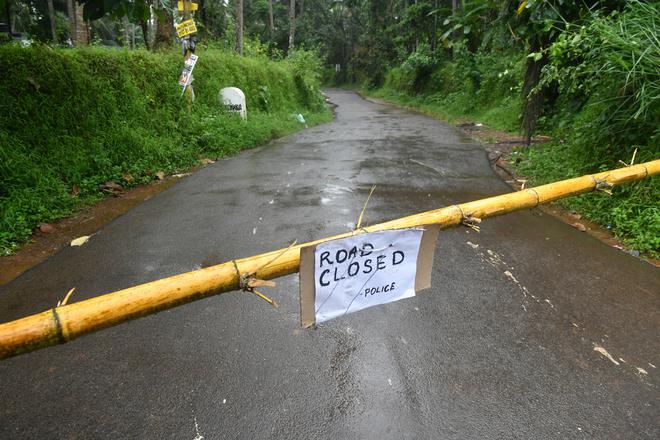A sense of dread is growing in Kuttiadi, a town located on the slopes of the Western Ghats in Kozhikode district of Kerala. Most shops are closed. Very few people can be seen on the road. The masks on their faces are reminiscent of a time not too long ago, when the COVID-19 pandemic gripped the world, and earlier, when the Nipah virus, unknown and exotic, crept into Kerala society.
No one knew it then, but the crisis began on August 30 when a feverish E. Mohammedali, 47, a native of Kallad in the Maruthonkara gram panchayat, not far from Kuttiadi, died at a private hospital in Kozhikode. Hospital authorities declared that he died of pneumonia. Later, Mohammedali’s young children, brother-in-law aged 24, and a relative who is just 10 months old were all hospitalised with similar symptoms.
Editorial | Unified approach: On the Nipah outbreak in Kerala and a One Health approach
Then, on September 11, alarm bells rang when M. Haris, 40, of Mangalad in the Ayancheri gram panchayat near Vadakara, died at a private hospital in Kozhikode. Haris had reported the same symptoms as Mohammedali — high fever, fatigue, and respiratory issues. Doctors suspected that he had died of the deadly Nipah virus, which has a mortality rate of 40% to 75% according to the World Health Organization (WHO).
The news of the infections was nothing new for the residents of Kozhikode district, which has seen three outbreaks of the Nipah virus so far. The first instance was reported in May-June 2018. Despite the government’s best efforts then, the virus infected 23 people and killed 21 of them from the Kozhikode and Malappuram districts. In June 2019, a lone case was reported from Ernakulam; the person recovered. On August 31, 2021, Mohammad Hashim, 12, of Pazhoor village near Chathamangalam in Kozhikode, had seizures. Hashim, the only child of Wahida and Vayoli Aboobacker, tested positive for Nipah and died just hours later. This is the fourth outbreak in Kerala. So far, two people have died and six are undergoing treatment.
A suspicion confirmed
This time, it was Dr. P. Jyothikumar, a general practitioner in Vadakara, who noticed something amiss when he was consulting patients at home on the morning of September 11. On the CCTV camera, Dr. Jyothikumar saw a patient staggering towards his room. “He was visibly tired. His arms were draped over the shoulders of two others,” Dr. Jyothikumar recalled. The patient, Haris, told the doctor that he had been suffering from high fever for five days. Haris had sought treatment at a private clinic, at government primary health centres, and at the Government Hospital in Vadakara, but his condition had not improved. “We ruled out chances of leptospirosis, dengue fever, malaria, and even leukemia. The patient’s liver function was normal. But I saw that his fingertips were turning blue,” said Dr. Jyothikumar.

Since he was unable to diagnose the patient’s condition, Dr. Jyothikumar contacted A.S. Anoop Kumar, a critical care specialist at a private hospital in Kozhikode, for an opinion. Dr. Kumar was among the first to suspect that the patients who had been admitted to his hospital with unusual symptoms in 2018 had been infected with the Nipah virus. “When I told him that this looked like a case of unusual fever with an undiagnosed condition, Dr. Kumar said that a couple of patients with similar symptoms had sought treatment at his hospital as well. Haris was subsequently referred there,” Dr. Jyothikumar said. It was soon established that Haris had visited the hospital where E. Mohammedali had died, since his relative had been undergoing treatment there.
Late on September 11, after the death of Haris, the office of the State Health Minister, Veena George, sent out an alert for Kozhikode district. The body fluid samples of Mohammedali were not sent for lab tests since there was no suspicion then that he had died of the virus. The samples of Haris and four others in the hospital were flown to the National Institute of Virology, Pune, on September 12. The results came that night. George informed an impatient media contingent outside the Government Guest House in Kozhikode that Mohammedali’s child aged nine and his brother in-law had tested positive for the virus; so had Haris. There was enough evidence to believe that Mohammedali, too, had been infected by the virus. Mohammedali’s samples were also sent to the lab. On September 15, it was confirmed that he had been infected.
A zoonotic illness
Nipah is a zoonotic illness, according to the WHO. Fruit bats of the family Pteropodidae — particularly, species belonging to the Pteropus genus — are the natural hosts for the virus. Nipah can be transmitted to people through infected animals, such as pigs and bats. In Malaysia, where the first case of the infection was reported in 1998, bats dropped partially eaten food near pig stalls. The virus travelled from bats to pigs and then to pig breeders. In Bangladesh, people were infected when they ate food contaminated by bats, such as raw palm sap. In India, the transmission from one person to another has taken place mainly through respiratory droplets. The virus moves to people who are in close contact with the patient, such as caregivers or medical staff.
While some people may remain asymptomatic, others may show symptoms such as fever, muscle pain, vomiting, headaches, and sore throat. Dizziness, drowsiness, altered consciousness, and neurological signs indicating acute encephalitis may follow. The WHO says people with severe infection get encephalitis and seizures and may end up in coma in 24 to 48 hours.
‘No words to describe the loss’
A pall of gloom has descended on Kallad. Mohammedali, from all accounts, was a socially conscious man. K.P. Rasheed, a resident of Kallad, described his friend as a silent worker, the kind who would make his presence felt even though he stayed in the wings. “He worked for many social causes. We have no words to describe the loss,” he said.
Mohammedali had been working at a private company in Al Ain in the United Arab Emirates for nearly two decades. About a year and a half ago, he returned home to take care of his father, who was paralysed. His house is empty now. All his family members are under medical isolation at a private hospital. Mohammedali’s brother E. Ansar said they are still in shock. “Other than a skin allergy for which he sought treatment, Mohammedali did not suffer from any other disease as far as I know,” he said over a phone call.

The residents of Mangalad are equally upset. Authorities have erected barriers on the way to Haris’s house. Haris had been working in Qatar. He had come home a couple of months ago and was planning to return on September 18. Local residents said he had lost his father some five years ago. An active worker of the Indian Union Muslim League, Haris had endeared himself to the people of the village, said the residents. “We don’t stay in the same locality. But every morning, we used to meet each other. I still can’t believe that he is no more,” his brother M. Nasar said over a phone call.
A. Surendran, ward member in Ayancheri Grama Panchayat, regretted the circumstances in which the residents find themselves. “We cannot even console his family members as they all are in isolation,” he said.
Also read | Connection between environment and epidemic in focus
The district administration has declared wards in at least nine gram panchayat as containment zones. The movement of people is restricted. All major public events in Kozhikode have been banned till September 24. Schools and colleges have been closed for a few days. On September 14, the police were seen discouraging people on motorbikes from going to areas declared containment zones.
Finding the source
The Union government has sent a team of experts to Kozhikode to assess the situation. Mobile labs have been set up at the Government Medical College Hospital premises to speed up tests of suspected patients. An isolation block too has been kept ready.
While applauding the Health Department for taking steps quickly to contain the infection yet again, health experts and the people have also raised questions about recurring outbreaks of Nipah in Kerala, and particularly Kozhikode, when there are virus-carrying bats elsewhere in the country. Many also wonder why the Health Department still does not have a mechanism to detect such cases quickly and act to prevent deaths.
P.O. Nameer, dean, College of Climate Change and Environmental Science, Kerala Agriculture University, Thrissur, pointed out that it was not clear why these infections were recurring in Kerala, especially in Kozhikode. “We still have no clear scientific proof about the source of the virus in Kerala. Our conclusion that fruit-eating bats are the source of the infection is based on similar episodes from other countries, and after detecting the presence of the virus in bats collected from the affected areas,” he said. There is no evidence to show how the first patient got infected during each of these outbreaks; it is assumed that they ate fruits contaminated with bat saliva or came in contact with the body fluids of bats.
A biodiversity expert, who did not wish to be named, said that Janakikkad, a biodiversity hotspot, is close to Sooppikkada, where the infection was first reported in 2018, as well as Kallad. “We need to know if the bats are coming out of their habitats in search of food. If that is the case, perhaps there is a drop in the number of fruit plants there. One way to stop the bats from coming to human habitats is to plant saplings,” he said.
Studies should be done to explore whether the growing presence of rubber plantations is affecting the bats and their ecosystem, he said. “Another cause of concern could be the high sound levels from quarries which may be disturbing the bats,” he said. A buffer zone could be created around forest areas so that the bats don’t journey into human habitats, he suggested.
“The main problem from a public health perspective is that the system starts thinking about a disease only after people are affected,” said M. Muraleedharan, national convener, anti-microbial resistance committee, Indian Medical Association. “Often, we jump in to solve an issue when it happens and then forget about it. The public health mechanism should have details about such diseases, their causes, the possible methods to avoid their outbreaks, and the steps to contain them as and when they happen.”
A microbiologist working with a government department said on the condition of anonymity that ground-level health workers need to know more about the initial symptoms of such infectious diseases so that the information can be quickly passed on to higher levels and the spread be stopped. If there is an ‘unusual death’ reported of a person below the age of 50, it should be suspected to be linked with Nipah, he added.
Dr. Muraleedharan said that when the infection was first reported in Kozhikode in 2018, there were plans of conducting a surveillance of bats. However, this has not taken place yet. An isolation block for Nipah at the Medical College Hospital was proposed and a sum of ₹25 crore set aside for the purpose, but nothing has come of it, he alleged.

Nameer pointed out that in countries such as Bangladesh and Malaysia, the health authorities were able to track the source of transmission of the virus from bats to human beings. In three-four years, they were able to prevent recurrence. “But in Kozhikode, we are yet to identify the spillover mechanism. Only if we identify it can we contain it on a long-term basis and take preventive steps,” he said. “Conducting a systematic bat survey and putting in place a multi-disciplinary team drawn from various departments such as forest, wildlife, and animal husbandry would be useful. That would also help us identify the focus areas to utilise our resources effectively,” Nameer added. The Kerala University of Health Sciences has taken preliminary steps in this regard.
Dr. Muraleedharan said that the State should have a testing lab with Biosafety Level-IV standards so that the samples do not have to be sent to the National Institute of Virology every time there is an outbreak. “Also, when infections are reported, we need to have a permanent protocol to treat the patients in the model of the Centers for Disease Control and Prevention in the United States. We need to have a system in place that can act immediately as and when infectious diseases are reported,” he said.







